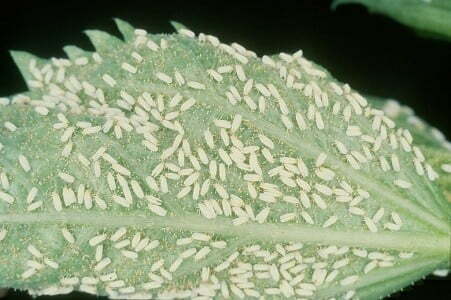Pest on pepper plants can be controlled. In general, pest management on pepper has a proven way. We just have to imitate and do it.
Starting from synthetic methods and organic methods, many pepper plant pests have been successfully controlled. Pests on this plant is not the most difficult pest. Although the number of pests in pepper is a lot, but the research is also a lot. to get this information is not difficult anymore.
What diseases in peppers plants?
Broadly speaking, peppers disease can be caused by these three things. The first is a fungus, the second is a pest and the third is a virus. For the type of disease, there are about 15 types of diseases that often attack peppers.
By knowing the type of disease and its causes, we can properly deal with it. We will discuss this here.
Table of contents
Pest on Pepper Plants due to Fungus
1 . Peppers Leaf Spots

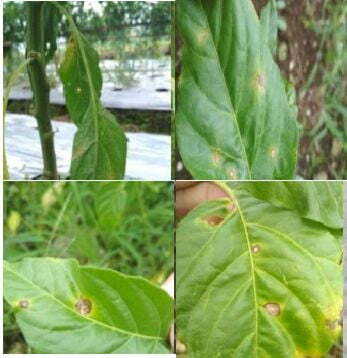
Leaf spot is the most common attack experienced by peppers plants. Leaf spots are caused by fungus. The type of fungus is Cescorpora sp. More specifically by Cercospora capsici.
Its characteristics are the presence of spots on the peppers leaves. These patches are getting wider.
This fungus attack can interfere with the photosynthetic activity of the leaves so that the leaves will turn yellow and fall off.
As is the nature of fungus, they thrive in high humidity. And the temperature or ambient temperature that supports it is between 27-28 0C.
In fact, at humidity between 60%-70%, this fungus is found in peppers plants.[1] Hence, it is not surprising that leaf spot attacks on peppers often occur in the rainy season.
This fungus can attack peppers in the highlands to the lowlands. Attacks do not only occur on leaves, but can also occur on fruit stalks and small stalks. But the dominant is found in the pepper leaves.
This fungus can survive from season to season on plant debris that is infected or carried by seeds.
Prevention is by planting the sterile seeds and not contaminated by this fungus. As for the seeds, I’m sure the certified seeds are free from this fungus.
Control of this fungus can be done by destroying the leaves or stems that are attacked.
Destroying is not just picking up leaves and throwing them on the ground. If only that, the fungus can still live and continue the cycle. Destroying is by burning only.
Treatment of this fungus can use fungicides. Chemical or organic fungicides as long as they are effective in eradicating mold, it can be used.
The active ingredients of chemical fungicides on the market are:
- Dimetomorf 50%
- Propineb 70%
- Mankozeb 80%
2 . Anthracnose
This is also one of the pest on pepper plants caused by fungus. The species is Colletotrichum spp. The environment that supports the development of this fungus is similar to leaf spot.
This fungus predominantly attacks on pepper plants.
The Symptoms on the fruit are characterized by the presence of brown or black spots that are slightly concave inward. The initial attack, fungus forms blackish brown spots on the surface of the fruit, then becomes soft rot.
The center of fruit appears like a collection of black dots which are groups of conidia.
Heavy attacks cause the whole fruit wrinkled and dry out. Fruit skin colour resembles rice straw. In hot and humid weather conditions, this desease growing faster.
This fungus can last a very long time. Because it will attack the peppers seeds. If this seed is used again, then the cycle will repeat itself.
That is, the fungus attacks the stem and then spreads in to the fruit. Control and treatment are almost the same as leaf spot.
Namely, fruit or parts of the infected peppers plant are destroyed by burning. Or, by using the fungicide above.
Prevention of this anthracnose is to do good irrigation and watering on peppers. As well as adding calcium.[2]
3 . Fusarium wilt on peppers

There is one more disease in peppers plants caused by fungi. That is fusarium wilt. The type of fungus is Fusarium sp, while the species is Fusarium oxysporum f. sp.
Symptoms of fusarium wilt in peppers plants begin with the blanching of the leaf bones, especially the upper leaves, followed by drooping of the stems, and finally the peppers plants wilt as a whole.[1]
Fusarium sp. Infects from the roots and then throughout the plant, through the xylem vessels, thereby disrupting the process of water transport and nutrient absorption in plants. Finally, the plants wilt.
Prevention, control and eradication of peppers disease is almost the same as the two peppers diseases above. That is the same – both caused by a fungus.
Pest on Pepper Plants due to insects
The truly pest on pepper plans are caused by insects. Fungus and virusses cause diseases on peppers. Suppose its same.
Insect attacks on peppers are actually easier to observe. Because the insect can be seen with the naked eye.
1 . Thrips

The first pest on pepper plants is thrips. Trips are insects with a small size. Its size is about 1 mm. With a slender body that extends between 0.5 – 14 mm.
Thrips can attack peppers plants since the plants are in the nursery. These pests work by grinding leaves, shoots and fruit and sucking plant fluids using their mouthparts.
The result is:
- Infected plants dry out and produce a silvery color, curly leaves, and stunted terminal shoots.
- Affected flowers and leaves cause symptoms in the form of white spots or silvery red spots and curled or wrinkled leaves.
- In severe attacks, it causes leaves, shoots roll inward and appear lumps like tumors, stunted plant growth and even plant shoots die.
Thrips can attack peppers plants all year. With a life cycle of only 2 – 3 weeks, thrips can attack many times if not treated properly.[3]
Controlling thrips can be done with the following steps.
- Planting pepper by intercropping.
- Good sanitation.
- Install insect traps.
- Take advantage of natural enemies.
- Chemical or natural insecticide.
This intercropping, intends to plant trap crops. That is the plant that is preferred by thrips pests.
Usually, this is from vegetables such as mustard greens, cabbage, tomatoes or corn.
So, the priority of crop yields is of course the main crop, the peppers. While the trap plants, let it go of being attacked by the thrips.
Good sanitation mean there is no stagnant water around the garden or land. If rains, then the rainwater must flow smoothly. All the rain water should came out of the garden.
Not only that, the affected plant parts should be destroyed by burning.
The use of blue or white traps is 40 pieces per ha or 2 pieces per 500 m2, and installed since the plants are 2 weeks old. This trap is hung above the peppers plant. The glue used is in the form of diluted wood glue or vaseline, glue is installed once a week.
The natural enemies of these thrips are Coccinellidae beetles, mites, larval predators of Chrysopidae, Anthocoridae ladybugs and the pathogen Entomophthora.
But how to care of their natural enemies is quite a troublesome additional work.
If you have given up on the methods above, you are forced to use chemical insecticides. There are many types on the market. Please look for it yourself.
2 . yellow mite
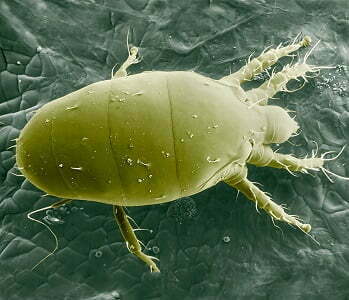
This pest on pepper plants is almost the same as thrips. But, it is a little different. The illustration can be seen in the image below.
These mites work in the same way as thrips. They are sucking plant fluids so that plants damaged.
As a result of yellow mite attacks, peppers become:
- Thickened leaves.
- Change in the color of leaves to copper/brown.
- The leaves are twisted, shriveled and curled.
- Shoots and flowers fall
The control and eradication of yellow mites on peppers is the same as for thrips. Because the attacks of these two types of insects are usually together.
3 . Fruit fly
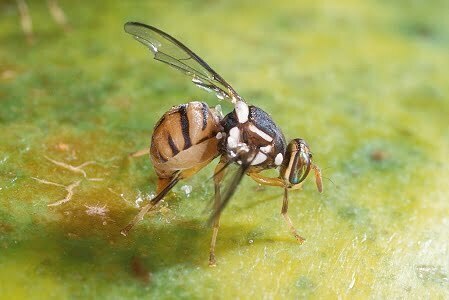
The shape is almost the same as a fly in general. But the color is brighter. Namely, there is yellow with black stripes
This fruit fly is very damaging to peppers fruit. Because of its short life cycle of 25 days. And once laying eggs, the parent can lay as many as 1200-1500 eggs.
These flies will lay their eggs at the base of the peppers. Then when these eggs hatch, the thousands of larvae will eat the peppers from the inside.
As a result, the peppers will rot.
The way to deal with fruit flies is by following these steps:
4 . Peach aphids
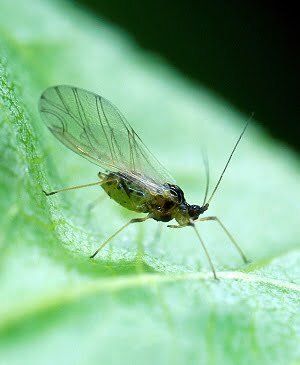
This pest on pepper plants has a fairly fast reproductive cycle. That is only 10-12 days. With the resulting tillers per cycle about 50 tails.
If it is not addressed immediately, the number will quickly explode and the impact of the damage will be more severe.
The damage done by peach aphids to peppers is similar to that of thrips and yellow mites.
When peppers are attacked by peach aphids, here’s what happens:
- Wrinkles,
- stunted plant growth,
- yellow leaf color,
- twisted,
- Withered
- Finally dead.
- Triggers fungal attacks.
- Spread of disease caused by viruses.
How to control and cope with the attack of peach aphids is as follows.
- Discard and burn plants or parts of peppers plants that are infested.
- Grow peach aphid repellent plants. An example of a crop is leek and can be planted intercropping with peppers. Plant trap crops such as caisim mustard. When a lot of fleas attack the caisim, destroy it immediately with insecticide.
- Use of yellow water traps. The traps needed are 40 pieces per ha or 2 pieces per 500 m2, installed when the peppers plants are 2 weeks old.
- Seek their natural enemies, like the parasitoid Aphidius sp, predatory beetle Coccinella transversalis, Menocvhillus sexmaculata, larvae Microphis lineata, Veranius sp and pathogenic Entomopthora sp.
As usual, the final step is using insecticide.
5 . pest of pepper plant : Spodoptera litura
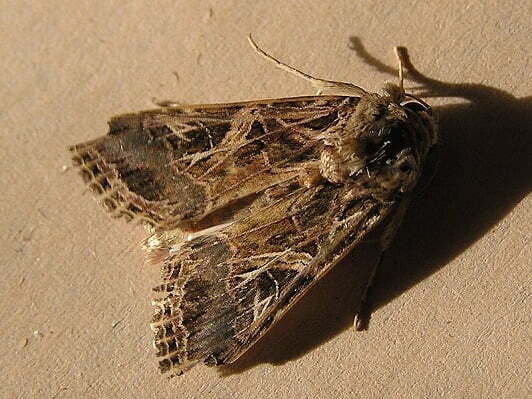
Armyworms are children of moths. The name of the moth is Spodoptera litura. The appearance of the moth is as in the image below.
The moth will lay eggs and when the eggs hatch, they will become very many caterpillars.
Because once laying eggs, moths can produce as many as 2000-3000 eggs.
This number of caterpillars can eat peppers leaves overnight. Because when the size of the caterpillar gets bigger, it eats more and more quickly.
These caterpillars will eat peppers leaves from the bottom. Then leave a little upper leaf so that the leaves look like transparent.
The peppers will look bald with only the bones of the leaves remaining.
This caterpillar is active at night. Meanwhile, during the day the caterpillar hides.
How to control and deal with armyworms on peppers is as follows:
- Destroy infested plants, caterpillars and moth eggs found.
- The use of sex pheromonoid traps for moths as much as 40 pieces per ha or 2 pieces per 500 m2. Trap installation is done since the plants are 2 weeks old.
- The natural enemy of the armyworm is the pathogen Sl. NPV (Spodoptera litura Nuclear Polyhedrosis Virus), Bacillus thuringiensis, Beauveria bassiana, fungus cordicep, Nematoda steinerma, predatory Sycanus sp, parasitoids Apanteles sp, Telenomus Spodopterae and Peribeae sp.
- Pesticide.
6 . whitefly
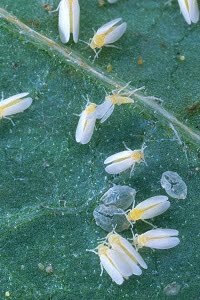
This is one of pest of pepper plants that have clear wings covered with a powdery wax coating so that when it flies it looks like a white cloud.
The attack on the leaves is in the form of necrotic spots, due to attacks by nymphs and adult insects.
When the population is high, whitefly attacks can inhibit plant growth.
The secretions released by the whitefly can cause black sooty fungus attacks, attacking various stages of plants.
How to deal with whitefly on peppers plants can be done in the following ways:
- Destroy infested plants by burning.
- Planting trap crops such as corn, long beans and succulents. The location of the trap plants on the edge of peppers as a fence.
- Crop trap intercropping. Examples of mustard greens and tagetes.
- Natural enemies. Example: Menochilus sexmaculatus (capable of eating 200-400 larvae/day of Bemisia tabaci), Coccinella septempunctata, Scymus syriacus, Chrysoperla carnea, Scrangium parcesetosum, Orius albidipennis, etc. The parasitoids known to be effective against B. tabaci are Encarcia adrianae (15 species), E. tricolor, Eretmocerus corni (4 species). while the types of pathogens that attack B. tabaci include Bacillus thuringiensis, Paeci/omyces farinorus and Eretmocerus.
- Installation of yellow sticky traps (40 pieces/ha).
- Pesticide with active ingredients permethrin, amitraz, fenoxycarb, imidacloprid, bifenthrin, deltamethrin, buprofezin, endosulphan and acefat.
Diseases / pest on pepper plants due to bacteria and viruses
1 . Gemini Virus
Gemini virus or also known as yellow virus. The virus is named YLCV (yellow leaf curl virus).
Virus attacks on peppers are more dangerous than fungi and insects. This is because the virus enters the plant tissue. External medicine will not touch it.
Plants that are infected with the virus will have yellow leaves (really yellow).
But uniquely, this pepper disease is not transmitted through contact between pepperes or seeds. The only one that can transmit and spread the virus to other plants is the whitefly insect.[2]
Prevention and control of the Gemini virus attack on pepper are as follows:
- Treat the whitefly first. Because these animals are the main culprits in transmitting the virus.
- Plant seeds or varieties that are resistant to the gemini virus.
- Use healthy seeds (not containing viruses) or not from infected areas.
- Perform crop rotation with non-Solanaceae and cucurbitaceae plants.
- Closing the nursery since the seeds are spread to prevent the entry of virus vectors by using insect nets.
- Eradication (destruction) of diseased plants by pulling and destroying by burning.
- Sanitation of the environment around the plant, including weeding weeds and other wild plants that can become temporary hosts for viruses or hosts for vectors (carriers and spreaders of viruses, for example: whitefly).
- Pesticide.
2 . Bacterial wilt
The name of the bacteria that attacks is Ralstonia solanacearum. These bacteria are in the soil and attack pepper plants through the roots. Then spread to the stems and the entire plant.
Pepper plants that are attacked by battery wilt will wither. Wither wither wither.
Without warning and signs of yellowing leaves first. Today’s greenery is fresh, tomorrow’s plants are wilted. Though the stems and leaves are still green.
What should be done to avoid bacterial wilt attack on pepper?
- Planting varieties of pepper seeds that are resistant to bacterial wilt.
- Soaking pepper seeds for 6 hours in a solution of Pf antagonist microbial (Pseudomonas fluorescens) at a dose of 20 ml/1 water.
- Giving Trichoderma spp and Gliocladium spp to the nursery media as much as 5 grams/bag of seedling.
- Destroy infested plants by burning.
- Do crop rotation. The plant must be in addition to the bacterial wilt host. Host plants other than pepper are tomatoes and potatoes.
- Aeration should be good. High soil moisture content increases bacterial wilt attack.
 JOYNIM FARM Goat Farming, Cattle Farm, Laying Hens, Quail Farm, Gardening
JOYNIM FARM Goat Farming, Cattle Farm, Laying Hens, Quail Farm, Gardening
